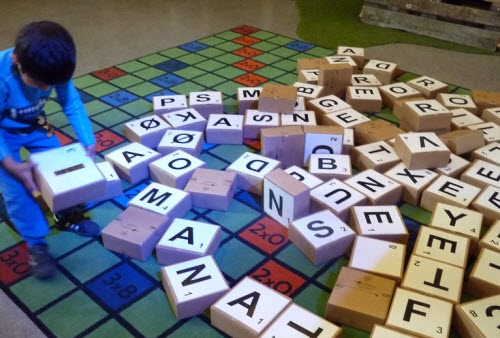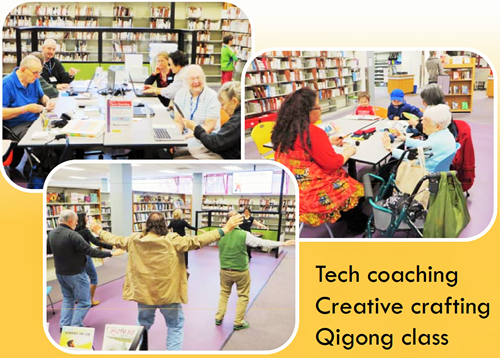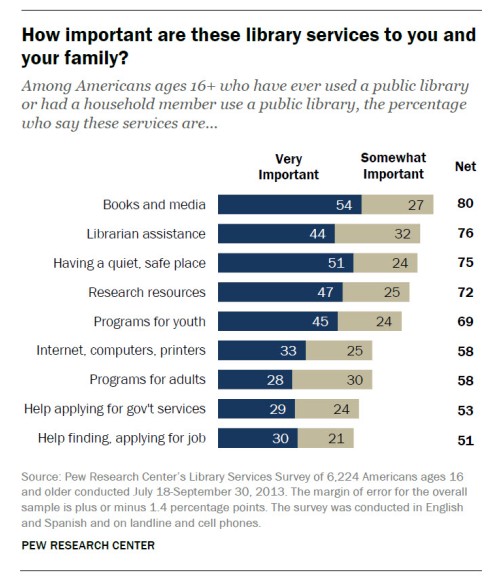Sustaining Communities, Sustaining Ourselves
 "When everything is online, why come to the library at all? The library of the future most certainly is not about storing books, but what is it? Well, we get to decide. That means, we get to do what we want, and everything is allowed."
"When everything is online, why come to the library at all? The library of the future most certainly is not about storing books, but what is it? Well, we get to decide. That means, we get to do what we want, and everything is allowed."
- Chrystie Hill at TEDxRanier - Libraries Present and Future
Aarhus Public Libraries in Aarhus, Denmark, built their new library using a process they call Participatory Democracy in Action. They did so by asking their community the question in the quote above, "If everything is online, why come to the library at all?" Feedback came from all over, children and adults, and had a huge impact in shaping the plan for the new Aarhus library building, Dokk1, which will open later this year on the harbour front in Aarhus.
What they achieved in Aarhus is not just a beautiful new library building offering innovative services, but a library that was planned, from the ground up and with the participation of its community, to serve the community in the ways that the community said it wanted to be served. Since the new library hasn't opened yet, it's still too early to say what impact this type of participatory planning will have, but odds seem good that the library AND the community will thrive because of this connection between the two throughout the entire process.
When the services and space of the library meet the needs of the community, the library will help to sustain that community and the community, in turn, will sustain the library.
[Take the poll: What makes a library sustainable?]
Chrystie Hill presents at TEDxRanier on Libraries Present and Future. Video uploaded to YouTube on December 28, 2011. Courtesy of TEDx Talks.
Sustainability starts with communication
You can call it advocacy, marketing, or demonstrating impact; you can call it outreach or "embedding" or engagement - whatever you call it, though, sustaining communities (and sustaining libraries) starts with communication. In Aarhus, that involved communication from concept through completion, and it seems like a good model to follow. Of course, we can't all build new libraries just to test this practice, but we can look at the services we are providing, the space we have in our buildings and what we are doing with it, and we can invite the community into a conversation to talk about these things and tell us what they want.
Are we really talking about DIY -- it's starting to feel like 'do it together.' Now what does that look like?
- Beth Farley, Bellingham Public Library (WA)
 In our recent webinar on Transforming Library Space, Beth Farley shared some of her experiences conceptualizing and creating SkillShare, an alternative programming space that's now located in the sweet spot between holds, new books, and the self-check stations that many library visitors never venture beyond. The library wanted a space with fewer hurdles than their traditional meeting rooms, one that would serve as a venue for community members to present and engage in a more informal setting.
In our recent webinar on Transforming Library Space, Beth Farley shared some of her experiences conceptualizing and creating SkillShare, an alternative programming space that's now located in the sweet spot between holds, new books, and the self-check stations that many library visitors never venture beyond. The library wanted a space with fewer hurdles than their traditional meeting rooms, one that would serve as a venue for community members to present and engage in a more informal setting.
But it didn't take shape under library steam alone. Friends groups purchased technology and worked late hours. Architects donated ideas and time. Visionary volunteers emerged and brainstormed. The result was an amazing restructuring of space that was built not only with community needs in mind but with community involvement through every step of the process.
Why come to the library at all?
Everyone who is strongly connected to libraries has their own answer to this question, but does your library understand it's value to the patrons that use it? What about the people who aren't using the library? What answer can we give them to this question that will bring them in the doors and make them active, participating members in the library and in their community?
 Every community is different, but there is some broad research that can help libraries get started answering these questions. Lee Rainie, Director of the Internet and American Life Project at the Pew Research Center, has given some excellent talks about people who use the library (and people who do not). In his examination of patron profiles, Rainie explores who our patrons and non-patrons are, what their information needs are, what kinds of technology they use, and how libraries can meet the varying needs of their patrons.
Every community is different, but there is some broad research that can help libraries get started answering these questions. Lee Rainie, Director of the Internet and American Life Project at the Pew Research Center, has given some excellent talks about people who use the library (and people who do not). In his examination of patron profiles, Rainie explores who our patrons and non-patrons are, what their information needs are, what kinds of technology they use, and how libraries can meet the varying needs of their patrons.
Pew surveys obviously cover a very wide net, but there are many ways that libraries can use similar tools to touch the pulse of their communities. In our recent webinar on Library Surveys for Success, Colleen Eggett from the Utah State Library shared strategies on how to create successful surveys to make, measure, and meet your library's goals.
And if you don't want to make your own survey instrument, there are tools out there for you to use. The Impact Survey, evolved from the 2009 Opportunity for All study, makes the complex job of surveying patrons easy and fast at no cost to library staff. Libraries can implement this survey quickly, run it for 2 to 6 weeks, and the day after they close it they will receive a suite of professional, full-color reports customized with your library's survey results. In addition to graphs and charts analyzing your survey responses, the standard reports include an op-ed customized with your survey results ready to submit to your local paper; an advocacy flyer featuring your survey results with regard to education and employment; and a ready-made presentation about your library's outcomes, ready to share with the city council, commissioners, service groups, or others.
Read more about the Impact Survey in our recent news article, or watch our webinar with Samantha Becker and Maggie Buckholz which covers how to implement the survey and the results you will see.
Lee Rainie presents as the Tuesday Keynote speaker at Internet Librarian conference, 2013. Lee starts his presentation around the 6m 28s mark. Video courtesy Steve Nathans-Kelly on Vimeo.
We get to do what we want, and everything is allowed
The library that is sustained by the community will be the library that sustains the community; the two are inextricably linked. Library staff need to not just be a part of the library, but also a part of the community; they need to talk to other people in the community (both inside and outside of the library) and find out how they can, as people and as an organization, help the community thrive.
The best part is, we get to be a part of figuring that out. Maybe we can't all build a new library on the harbour front, but we can listen and we can learn and we can make changes, and we can tell ourselves and our communities that the library that will hold up for years and years to come is going to be a new library, whether or not it is in a new building, and everything is, in fact, allowed.
http://www.webjunction.org/news/webjunction/sustaining-communities-sustaining-ourselves.html